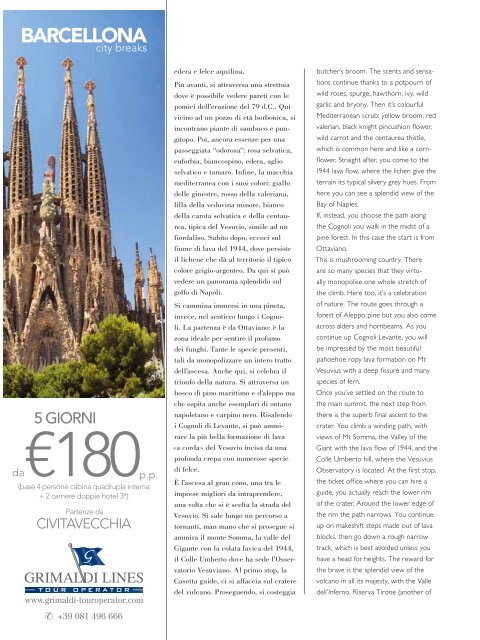umenitsa - Patras - Grimaldi Group
umenitsa - Patras - Grimaldi Group
umenitsa - Patras - Grimaldi Group
You also want an ePaper? Increase the reach of your titles
YUMPU automatically turns print PDFs into web optimized ePapers that Google loves.
84 +39 081 496 666<br />
edera e felce aquilina.<br />
Più avanti, si attraversa una strettoia<br />
dove è possibile vedere pareti con le<br />
pomici dell’eruzione del 79 d.C.. Qui<br />
vicino ad un pozzo di età borbonica, si<br />
incontrano piante di sambuco e pun-<br />
gitopo. Poi, ancora essenze per una<br />
passeggiata “odorosa”: rosa selvatica,<br />
euforbia, biancospino, edera, aglio<br />
selvatico e tamaro. Infine, la macchia<br />
mediterranea con i suoi colori: giallo<br />
delle ginestre, rosso della valeriana,<br />
lilla della vedovina minore, bianco<br />
della carota selvatica e della centau-<br />
rea, tipica del Vesuvio, simile ad un<br />
fiordaliso. Subito dopo, eccoci sul<br />
fiume di lava del 1944, dove persiste<br />
il lichene che dà al territorio il tipico<br />
colore grigio-argenteo. Da qui si può<br />
vedere un panorama splendido sul<br />
golfo di Napoli.<br />
Si cammina immersi in una pineta,<br />
invece, nel sentiero lungo i Cognoli.<br />
La partenza è da Ottaviano: è la<br />
zona ideale per sentire il profumo<br />
dei funghi. Tante le specie presenti,<br />
tali da monopolizzare un intero tratto<br />
dell’ascesa. Anche qui, si celebra il<br />
trionfo della natura. Si attraversa un<br />
bosco di pino marittimo e d’aleppo ma<br />
che ospita anche esemplari di ontano<br />
napoletano e carpino nero. Risalendo<br />
i Cognoli di Levante, si può ammirare<br />
la più bella formazione di lava<br />
«a corda» del Vesuvio incisa da una<br />
profonda crepa con numerose specie<br />
di felce.<br />
È l’ascesa al gran cono, una tra le<br />
imprese migliori da intraprendere,<br />
una volta che si è scelta la strada del<br />
Vesuvio. Si sale lungo un percorso a<br />
tornanti, man mano che si prosegue si<br />
ammira il monte Somma, la valle del<br />
Gigante con la colata lavica del 1944,<br />
il Colle Umberto dove ha sede l’Osservatorio<br />
Vesuviano. Al primo stop, la<br />
Casetta guide, ci si affaccia sul cratere<br />
del vulcano. Proseguendo, si costeggia<br />
butcher’s broom. The scents and sensations<br />
continue thanks to a potpourri of<br />
wild roses, spurge, hawthorn, ivy, wild<br />
garlic and bryony. Then it’s colourful<br />
Mediterranean scrub: yellow broom, red<br />
valerian, black knight pincushion flower,<br />
wild carrot and the centaurea thistle,<br />
which is common here and like a cornflower.<br />
Straight after, you come to the<br />
1944 lava flow, where the lichen give the<br />
terrain its typical silvery grey hues. From<br />
here you can see a splendid view of the<br />
Bay of Naples.<br />
If, instead, you choose the path along<br />
the Cognoli you walk in the midst of a<br />
pine forest. In this case the start is from<br />
Ottaviano.<br />
This is mushrooming country. There<br />
are so many species that they virtually<br />
monopolise one whole stretch of<br />
the climb. Here too, it’s a celebration<br />
of nature. The route goes through a<br />
forest of Aleppo pine but you also come<br />
across alders and hornbeams. As you<br />
continue up Cognoli Levante, you will<br />
be impressed by the most beautiful<br />
pahoehoe ropy lava formation on Mt<br />
Vesuvius with a deep fissure and many<br />
species of fern.<br />
Once you’ve settled on the route to<br />
the main summit, the next step from<br />
there is the superb final ascent to the<br />
crater. You climb a winding path, with<br />
views of Mt Somma, the Valley of the<br />
Giant with the lava flow of 1944, and the<br />
Colle Umberto hill, where the Vesuvius<br />
Observatory is located. At the first stop,<br />
the ticket office where you can hire a<br />
guide, you actually reach the lower rim<br />
of the crater. Around the lower edge of<br />
the rim the path narrows. You continue<br />
up on makeshift steps made out of lava<br />
blocks, then go down a rough narrow<br />
track, which is best avoided unless you<br />
have a head for heights. The reward for<br />
the brave is the splendid view of the<br />
volcano in all its majesty, with the Valle<br />
dell’Inferno, Riserva Tirone (another of

















